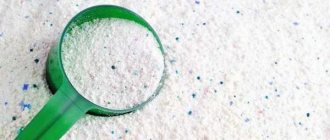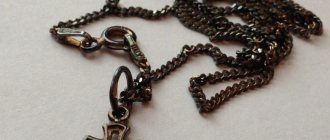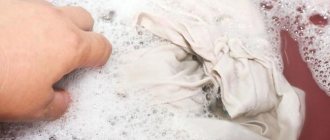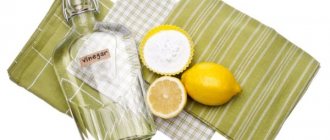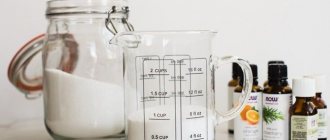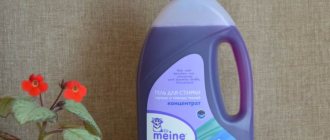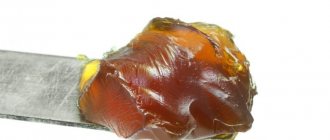Basic rules of whitening
Sweat and dust are absorbed into the fibers, causing the fabric to turn yellow. Such stains are difficult to remove, so clothes should be washed after 1-2 wears. Traces of tea, coffee, wine, and juices must be washed off immediately - stubborn stains are more difficult to remove.
Do not use chlorine bleach to wash white items: the product may cause the fabric to become thinner. If you need to bleach delicate materials, do not apply the product directly to the clothes - first you need to check the effect of the chemical on the lining.
Do not soak clothes with iron hooks, zippers, or rivets: they oxidize and leave rust marks. It is better to wash such items by hand at 30–40˚C, turning them inside out. After rinsing, wring out the fabric and blot with a terry towel - this will reduce the risk of rust marks.
Do not wash different types of fabrics at the same time. Cotton cannot be washed with wool and synthetics, otherwise it will take on a gray tint.
Why does white turn gray when washed in a machine?
First, you should figure out why, after washing, white linen becomes gray, that is, dirty, instead of being cleaned and brightened?
First, you should exclude gross violations of the washing rules: do not wash light-colored underwear with dark clothes, do not simultaneously wash smooth fabrics with those that can leave lint (such as angora knitwear), shake out sand, dust, crumbs and other loose particles from contaminated items, and etc.
But now you load, for example, snow-white bedding into the drum, and take it out “washed.” Why?
It's all about the temperature difference between washing and rinsing.
Washing is done in hot water - thanks to this, fat-containing microparticles of dirt “stick off” from the fabric and remain in the water. At this stage, your items are white and clean. But then the rinse cycle begins - standard rinsing modes usually require cold water to be poured into the drum. Meanwhile, dirt flakes do not completely drain off with the “washing” water - they stick to the walls of the drum and to the same things, because cold water stops the flotation process of hydrophobic particles. This is the same effect that prevents you from washing greasy dishes in cold water.
As a result, dirt, which was locally on the items before washing, settles on their entire surface, also penetrating quite deeply into the structure of the fabric fibers. Added to this may be dirt from previous washes remaining inside the washer.
When checking the laundry after washing, we notice that it has changed color and looks stale
How to bleach different types of fabric
Before work, study the label - it indicates the washing method and the maximum temperature setting. If you don't follow these rules, you can ruin the item.
Synthetics
When bleaching, synthetics should not be boiled - wash only in warm water. Do not use chlorine-containing products or soak white synthetic items - this can only be done when bleaching tough stains.
To preserve the appearance and color of the item, spin the clothes at low speed in the washing machine and hang them in direct sunlight.
Natural fabrics
Natural fabrics are stronger than synthetics, so you can bleach cotton and linen clothes by any means, including home methods and household chemicals. As a rule, such fabric can be boiled, washed in a washing machine, rinsed and wringed. But it all depends on the quality of the material, so before washing, read the information on the label.
But it is better to avoid chlorine bleach: the product will shorten the service life of even such dense materials.
Delicate fabrics and wool
Delicate fabrics and wool should not be washed at high temperatures, boiled or soaked in hot water - they may shrink. Capricious fabric can be bleached with soda, ammonia and soaked in warm water for 2–3 hours. Wool is bleached with salt and hydrogen peroxide.
Prevention of yellow spots
Yellow marks on clothing can be caused by more than just sweat and deodorant. Yellowing is caused by violation of washing and ironing rules, hard water, and improper storage.
Washing, drying and ironing according to the rules
To prevent yellow stains from appearing on your clothes while caring for them, do the following:
- do not overload the washing machine;
- select a washing mode with additional rinsing;
- do not add more washing powder and bleach than recommended in the instructions;
- Wring out your laundry thoroughly before hanging it to dry;
- Set the iron setting according to the type of fabric.
These simple rules will help keep things white longer.
Water softening
Hard water causes soap scum to form. To prevent the problem, use water softeners for washing machines, for example, Calgon 2 in 1, or wash with powders that contain softeners - Persil, Ariel.
Special means
There are four types of bleaches: chlorine, oxygen, optical and stain removers. They have different active composition and effects. Let's look at how to restore whiteness to white things using these means.
Chlorine bleaches
Can only be used for bleaching natural fabrics, but cannot be used frequently, otherwise the material will deteriorate. Before washing, put on rubber gloves to avoid injuring the skin of your hands. If you are sensitive to odors, wear a respirator.
Dilute one tablespoon of bleach in three liters of water, add a little washing powder and soak the item for 20-30 minutes. Then rinse thoroughly and wash. It may take several rinses to remove the pungent odor.
Oxygen bleaches
Vanish Oxi Action, Faberlic Exta Oxy, Synergetic are popular oxygen bleaches that do not damage the fabric structure, are completely rinsable and are suitable even for delicate fabrics.
Oxygen bleaches are produced in the form of gels, powders, and sprays. For hand washing items, use gels; for machine washing, use powders. If you need to remove the stain pointwise, you can use a spray.
How to use bleach, read the label: products even from the same cleaning group differ from each other.
Optical brighteners
This is a luminescent dye: it penetrates the fabric fibers and absorbs ultraviolet light, creating the illusion of whiteness. Typically, optical brightener is not used as a stand-alone product, but is added to oxygen stain removers and washing powders. Optical brighteners are harmless, but they are difficult to rinse out after soaking.
Stain removers
You can whiten white items using stain removers. Here are some popular remedies.
- Sil universal stain remover salt is applied directly to the stain and removes all types of stains from clothing at any temperature.
- Royal Powder effectively removes dirt and stains from white fabrics at temperatures from 30°C to 95°C.
- Amway SA8 powder is suitable for machine washing white and light cotton fabrics and gently bleaches them.
Professional bleaches…
There are situations when traditional methods do not work and you have to turn to professional bleaches. But which one to choose?
- Chlorine. The composition contains a large amount of chlorine. Used for cotton fabrics, linen, knitwear. Suitable when you need to renew bed linen that has yellowed from age. Is an excellent disinfectant. However, you should not use such means often. Due to aggressive exposure, fabric fibers become thinner. In addition, most bleach-containing products cannot be used in the washing machine.
- Oxygen. Oxygen-containing products are new generation bleaches without chlorine. They have a gentle and gentle effect on dirt, do not destroy the structure of the fabric, and can be used for both white and colored linen. They are safe for health and are approved for washing children's clothing.
- Optical. They create the appearance of whiteness, although they actually do not remove stains. Small shining particles fall on the fabric and visually make it whiter.
Traditional methods
In addition to chemicals, you can use traditional methods of whitening at home. Let's look at proven cleaning methods.
Boiling
You can boil cotton and linen clothes. Pour warm water into an enamel bucket or stainless steel container: for one kilogram of things - 10 liters of water. Pour one tablespoon of baking soda into the water and dissolve half a bar of laundry soap. Soak the laundry in a bucket and boil for one hour, stirring with wooden tongs. Then let the water cool and rinse the laundry thoroughly.
Hydrogen peroxide
Suitable for bleaching cotton, linen and synthetic fabrics. To clean, take fresh peroxide - a month after opening the bottle, it loses its cleaning properties.
Add one teaspoon of hydrogen peroxide to two liters of warm water, stir and soak the laundry in the solution for half an hour. Turn things over occasionally and then rinse thoroughly in cold water.
To enhance the whitening effect, add a spoonful of soda to the solution.
Boric acid
Mix one tablespoon of boric acid in two liters of water and soak the item for 1–2 hours. If things have a pronounced gray tint or spots, then add one tablespoon of laundry soap shavings to the solution. Then rinse the item in cold water.
Soda and laundry soap
You can bleach cotton and linen fabrics with baking soda and laundry soap. The method is not suitable for bleaching wool and silk. Add one tablespoon of baking soda and soap shavings to one liter of warm water. If you need to increase the displacement, follow the specified proportions of ingredients. Boil the item in the solution for 20–25 minutes and then rinse thoroughly in cold water.
Ammonia
Ammonia is suitable for bleaching cotton and linen, but it cannot be used for items made of thin fabric: ammonia can “corrode” them. Dissolve 3-4 tablespoons of ammonia in a bucket of warm water and soak the laundry for 2-3 hours. Then rinse and wash the item thoroughly.
Salt
Salt returns whiteness to grayed items and can be used as a preventative for any fabric. Mix two tablespoons of salt in one liter of water and soak the item in the solution for half an hour. Then rinse in cold water.
Aspirin
Aspirin whitens woolen items, removes traces of sweat and rust. It is not recommended to use it for other types of fabric. Crush the tablets and dissolve them in warm water in a 1:1 ratio. Soak the laundry for 6-8 hours and then rinse in cold water. Aspirin powder can also be used in the washing machine.
Vinegar
Distilled vinegar returns whiteness to fabrics and softens them. Add half a glass of vinegar when washing items in the washing machine. Or dissolve a glass of vinegar in 1-2 liters of warm water and soak the clothes overnight, and wash the clothes in any way in the morning.
Lemon acid
Cotton and linen items are bleached with citric acid. The method is not suitable for delicate fabrics. Mix one tablespoon of citric acid in one liter of water and soak the item in the solution for 4–5 hours. Then rinse thoroughly in cold water. If you add 1-2 tablespoons of washing powder to the solution, the whitening effect will be better.
Potassium permangantsovka
Potassium permanganate gently bleaches all types of fabric and removes color stains from white clothes. Dissolve 3-5 potassium permanganate crystals in a glass of water and mix thoroughly - the solution will turn pink. Add a solution of potassium permanganate and 150 grams of soap shavings to 10 liters of warm water. Soak the laundry in the resulting solution for 1–2 hours and then rinse thoroughly. If the item is thin, reduce the soaking time.
Mustard powder
Mustard whitens, removes grease and disinfects clothes. The method can be used for delicate fabrics. Add one tablespoon of mustard powder to a liter of boiling water, stir, let the mixture brew for 2-3 hours and strain. Soak the laundry for 1-3 hours: soaking time depends on the density of the fabric. Next, rinse thoroughly and wash.
How to bleach gray clothes at home?
The first thing you need to consider is what fabric the item is made from.
- For example, tulles, curtains, guipure napkins can be bleached with pharmaceutical peroxide and ammonia . These substances are present in every family's medicine cabinet.
- To do this, dilute 1 tbsp in 5 liters of hot water. l. each solution. Leave the laundry to sour in the resulting water for 30 minutes.
- For grayed cotton, you can use bleach or chlorine-containing products. To do this, pour bleach into a separate compartment of the washing machine in the dosage indicated on the pack.
- Set the machine to the intensive rinse and pre-wash mode.
- For synthetics, an alternative would be table salt . For half a liter of water - a heaping spoonful of salt.
- Leave the grayed socks in a soak with 1 tbsp. l. boric acid. The result will surprise you.
...and good old whiteness
The main representative of chlorine-containing bleaches is whiteness. This product is one of a kind - cheap and cheerful. The housewives have known him for decades. Whiteness helps to whiten faded items and removes stains from juice and coffee. But only natural cotton fabrics survive such procedures painlessly. To do this, you need to soak the laundry in water for 20 minutes, adding a tablespoon of white (for each liter). Do not allow the concentrated substance to come into contact with the fabric, otherwise it may be burned through. Clean laundry should be rinsed thoroughly in several waters.
Tips for caring for white sweaters
- In order to maintain the original appearance of the clothing, you must adhere to the recommendations indicated on the product label .
- Before you start washing, things are sorted . Natural materials cannot be combined with synthetic ones. Light sweaters are washed separately from black and colored items. Otherwise, the color will not be so snow-white.
- A dirty item should not be put in the laundry basket for a long time. Old stains are more difficult to remove
; there is a high probability that the product will acquire a gray or yellowish tint after washing. - In order for the jacket to be snow-white, you do not need to use bleach every time. Constant use of these substances leads to disruption of tissue structure. Bleach is recommended no more often than every 3-4 washes.
What is the name of a jacket with a hood?
How to quickly dry a jacket

